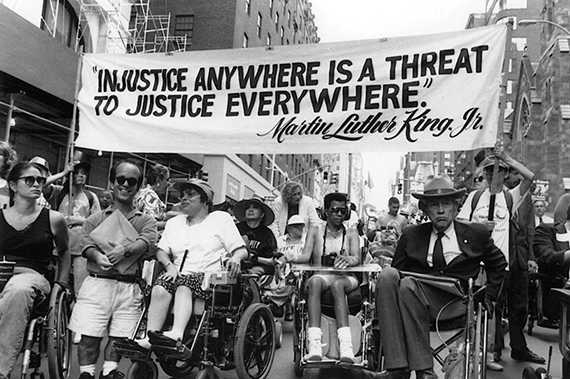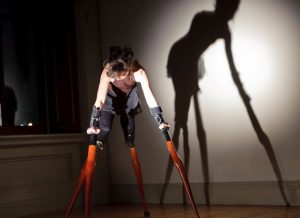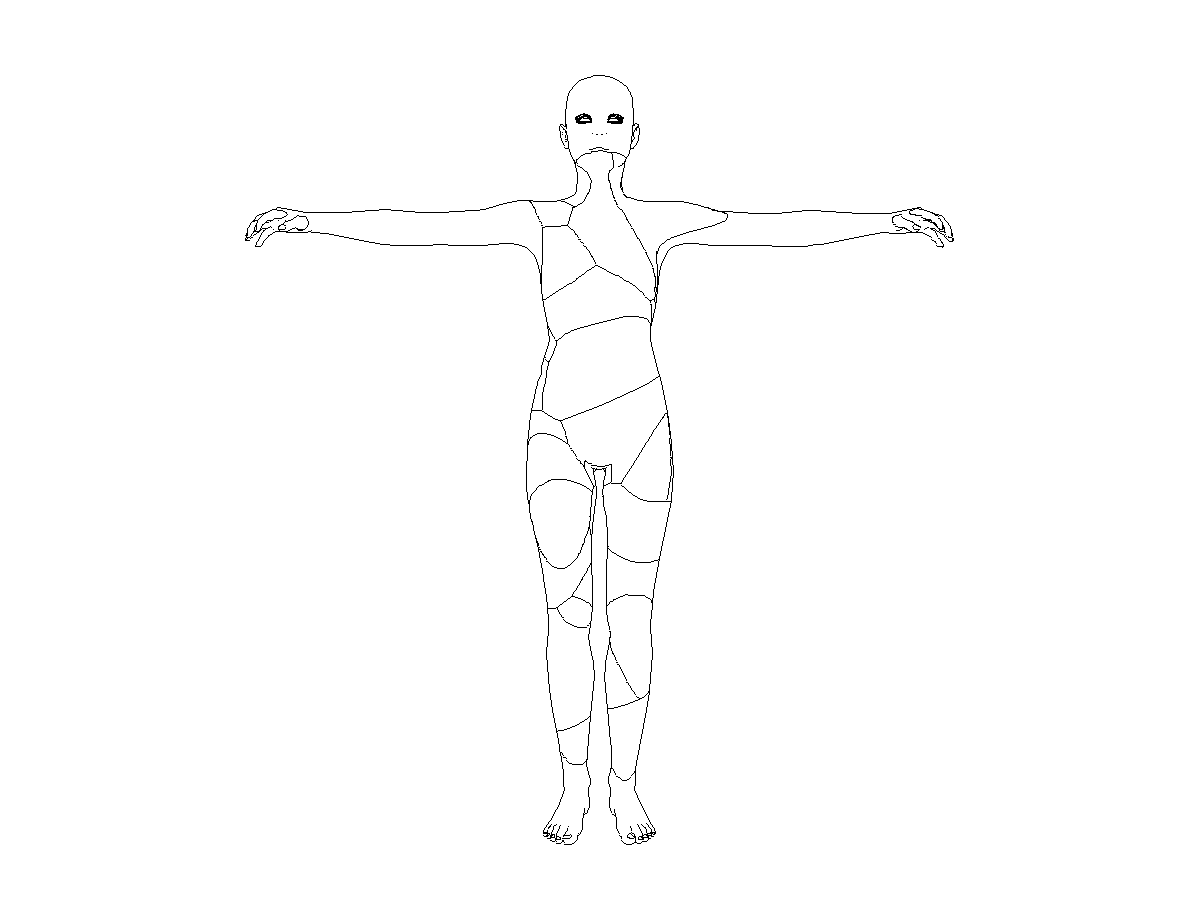
Art history has just entered into a new realm of visual culture. Because. The interdisciplinary approach to studying art history through a disability studies lens has recently emerged as a new field of scholarship. In fact. The very first volume to combine these two fields—disability studies and art history—was just released in December 2017. At the time I am writing this essay. December 2017 was only three months ago. Art historians Ann Millett-Gallant and Elizabeth Howie explain in this new volume, Disability and Art History, that addressing disability through art history uncovers new ways of thinking about art historical analyses. [1]
This essay is a project. In forwarding this new scholarship—the combining of art history and disability studies—this project puts art historians (writers and theorists) and disability scholars into conversation with each other. Considering. It is an attempt to understand disability theories and the scholars’ analysis of artworks and artists with disability. Because. While the subject of disability has not been completely excluded from art and art history as Tobin Siebers, an English scholar and disability studies advocate, suggests, it has played a hidden role, especially in art theory and criticism. [2]
This project, therefore, asks the questions: How can dialogues of disability in art continue to change? How can these dialogues shed new light on how disability is now being represented in the history of art? And. How can contemporary art theory and criticism also encourages more disability dialogues in art? So. Through an analysis of six prominent scholars in both disability studies and art history—Amanda Cachia, Rosemarie Garland-Thomson, Robert McRuer, Ann Millett-Gallant, Alison Kafer, and Tobin Siebers. This project is ultimately a literary review that seeks to answer the question above, communicate the importance of this relatively new perspective and its application in art history (writing, theory and criticism), and reveal its ever-increasing presence in postmodern and contemporary art.
With this in mind. This project seeks to further Siebers’ observation of how disability has become ever more apparent in art and art history since modern art. It shows that even though Seibers’ claim is accurate, theories of disability and analyzing art through a disability lens has only gained prominence since the early 2000s (i.e. postmodern art, contemporary art).
To give an idea of framework. Even though this is a project that puts these six scholars in conversation with one another, in addition to other prominent art historians and scholars such as Fredric Jameson, Gilles Deleuze, and Felix Guattari, there will not be five, clear sections dedicated to each author as separate case studies. Instead. I want to provide the reader with a framework that flows and jerks from a question, to ideas and comments, to answers, and back to questions. Because. While this project is an analysis of these various scholars. It is also in a state of multiplicity, always in a state of becoming. An idea that will be discussed later in the essay.

Before diving deeper into this discussion. It is important to first provide some context. In the past one hundred and forty years, disability has become increasingly more identifiable in art and art history, whether disability refers to disabled subjects in art, artists with disabilities, or even the disabled artist as subject (i.e. Bob Flanagan, the “Supremasochist,” seen left). In particular. Disability has gained special attention and recognition in modern and contemporary art history and theory. Especially. In the past twenty years. It has found its way into histories and theories of photography, feminist theory, queer theory, aesthetics, surrealism, among others. What is important here, however, is that while it has found its way into artworks and these histories and theories, the discussion of disabled artists and subjects is a relatively new one.
In fact. It wasn’t until 1990 that the United States government passed the Americans with Disabilities Act (ADA), the civil rights law that prohibits discrimination based on disability. Shortly after the ADA passed, disability studies—a social, cultural and political scholarship rather than a medical scholarship—became a topic of study at Syracuse University for the first time in history. Millett-Gallant shows in The Disabled Body in Contemporary Art medical models view disability and the disabled body as a set of medical “problems” that need to be fixed, cured, and eliminated while subsequently eliminating disabled people from the population. [3] So. Where medical scholarship looks at disability as a mutation or abnormality of the body, disability studies looks at disability as a social construction, a similar argument that has been made in gender, race, sexuality, ethnic, and class studies. Disability studies, therefore, “strives to establish a social model for disabled people as an oppressed group and forges alliances with theories and positions of other socially marginalized groups.” [4]
While disability studies does focus a lot of attention on civil rights and politics in the United States, just as critical theorist Robert McRuer explains in Crip Theory: Cultural Signs of Queerness and Disability, this is not to say that when it is combined with art history—and theory and criticism when analyzing past and contemporary artworks—it always remains political. It simply means. Looking at art history, artists, and artworks through a disability studies lens adds an additional layer of scholarship not previously explored.
So. It is from this point that disability studies begins to collaborate with art history. “This point” i.e. the mid-1990s is also around the time that art and literary critics, such as Fredric Jameson, begin defining the political, social, and economic culture of the 1980s and 1990s as postmodern. According to Jameson. Postmodernism is nothing more than a product of late capitalism, an “aesthetic populism.” [5] He criticizes postmodernity for being a cultural dominate, all-encompassing, and an approach to art that incorporates all styles from the past and thus destroys history. However. This project embraces postmodernism and shows that, while the movement may be categorized as a result of capitalism, it ultimately gives rise to varying new theories and approaches to art and art history, one mainly being disability studies.
 Indeed. While modernism was an age of theoretical binaries, postmodernism is one of multiplicity always in a state of becoming. And. it is through this state of multiplicity (i.e. Gilles Deleuze and Felix Guattari’s theory of striated to smooth, and smooth to striated) that disability studies and disability theories of analyzing art emerge. [6] In addition. This period of art is especially important when discussing disability in relation to art and art history, because as art historian Ann Millett-Gallant explains, “it sets the stage for relevant themes of self-exhibition, identity, and the role of the body in art and and society.” [7]
Indeed. While modernism was an age of theoretical binaries, postmodernism is one of multiplicity always in a state of becoming. And. it is through this state of multiplicity (i.e. Gilles Deleuze and Felix Guattari’s theory of striated to smooth, and smooth to striated) that disability studies and disability theories of analyzing art emerge. [6] In addition. This period of art is especially important when discussing disability in relation to art and art history, because as art historian Ann Millett-Gallant explains, “it sets the stage for relevant themes of self-exhibition, identity, and the role of the body in art and and society.” [7]
Feminist and queer theorist Alison Kafer and McRuer show that by combining queer studies with disability studies a new theory emerges; what they term, “crip theory.” I will not be discussing crip theory in too much detail here. But. What is important to note is that by “queering disability” Kafer and McRuer are attempting to erase the simplistic binaries associated with disability, i.e. disabled/non-disabled or sick/health. [8] They ultimately complicate the terms disability and crip by asking questions like, Can anyone identify or claim to be disabled or crip even when they do not have a disability? “What might it mean for lovers or friends to claim crip, or to understand themselves as ‘culturally disabled’?” [9] By replacing disability with crip. Each scholar provides crip theory with more fluidity and ambiguity so that it can be ever-changing, regenerative, more-encompassing to include more people than just a select few. Kafer and McRuer break down binaries in order to create multiplicity within disability studies, and in turn, make disability studies postmodern.
Similar arguments for multiplicity have been made in other interdisciplinary art theories/movements, most importantly in Margo Natalie Crawford‘s theory of black post-blackness. In Black Post-Blackness: The Black Arts Movement and Twenty-First Century Aesthetics. Crawford suggests the theory of Black Post-Blackness in order to show that black art in the twenty-first century is deeply connected with the Black Arts Movement (BAM) of the 1960s and 1970s. She emphasizes that “black consciousness-raising and black experimentation are inseparable”; that “being and becoming cannot be separated” [my italics]. [10] So. It is this aspect of postmodernism that disability theories in art history (theory and criticism) predominantly identify with.
Like black post-blackness, and Amelia Jones‘ argument against “post-feminism.” Looking at art history through a disability studies lens does not signify the end of something—as the prefix “post” in “postmodernism,” “post-black,” and “post-feminism” suggests—but rather signifies a state of becoming. [11] Because. As new ideas and theories of disability in art history (theory, criticism, etc.) emerge, the more these ideas and theories will connect to the past, present, and future. And. These new theories will continue to expose and reveal new layers of scholarship not previously investigated.
Millett-Gallant makes a related argument but terms this multiplicity in art and scholarship as simply “contemporary” rather than postmodern and gives special attention to visual culture in general. She explains that contemporary art, i.e. 1960s to the present, serves as an ideal medium for a disability studies lens because contemporary art is contemporaneous with “a number of civil rights movements, theoretical and artistic explorations of identity, interest in the dynamics of viewer reception, and in image explosion in our global, information-saturated culture.” [12] This emphasis on visual and information-saturated culture is directly related to the idea of postmodernism. As Jameson shows. Postmodernism isn’t only connected or defined as an art movement; postmodernism is also a cultural movement, an economical movement, and a political movement. The postmodern is all-encompassing.

But. As I have shown, this isn’t necessarily a bad thing (as Jameson would have it). Postmodern and/or contemporary art is fragmented, contingent, and thus, “ripe for interpretive interventions on traditional readings” of art. [13] The “all-encompassing” of postmodernism is what propels new viewpoints forward, because rather than being a binary, i.e. black and white, it is multiplicity, i.e. black, white, grey, and all the variations in between (as seen in the image on the left). In this way. It allows for and even encourages new perceptions of not only analyzing past and current artists and artworks, but new perspectives for creating fresh artworks (and vice versa). Thus. When looking at contemporary art through a disability lens, the idea of connecting disability theories to postmodernism isn’t about capitalism or aesthetic populism; it is about seeing art, culture, people, life, etc. in new light.
Another important element that connects with postmodernism and this emerging disability lens in art history is the philosophical theory of phenomenology. Phenomenology is a very significant aspect of disability theory. Because. Both theories heavily rely on the various experiences felt, sensed, observed, etc. through the body. Vivian Sobchack, an American media theorist and cultural critic, explains that being in our bodies “is a radically material condition of human being” that is always “mediated and qualified by our engagements with other bodies and things.” [14] Five of the focused scholars in this essay. Kafer, Siebers, Millett-Gallant, McRuer, and Cachia give particular attention to the body and concentrate on artists (both abled and disabled) that use their bodies as the subjects of their artworks.
Tobin Siebers’ most distinguished work Disability Aesthetics outlines the importance of disability as a lens in art history through disability’s attachment to aesthetics. According to Siebers’ definition. Aesthetics are more attached to bodily sensory knowledge rather than the purely rational. He shows. Through a selection of artists—who either identify as disabled or not—disability aesthetics is created as a critique of the traditional Hegelian aesthetic ideal, and more in line with the Kantian perspective aesthetics. Where Immanuel Kant introduces the idea of aesthetic judgement as a means to elevate sensory knowledge to the level of rational knowledge. Georg Wilhelm Friedrich Hegel defines a more hierarchical aesthetic philosophical view of sensory knowledge, making the sensory not as important as the rational. [15]

The artists Siebers mentions, such as Paul McCarthy, Nam June Paik, Carolee Schneemann (seen left), Mary Duffy, among others, turn “their own bodies into instruments or works of art” by either exhibiting themselves in ordinary situations or extraordinary ones. [16] Therefore. The body is the most integral element not only in disability aesthetics but in disability’s application to art history. Because. It is the body that houses the consciousness, the mind, and the brain. And. It is through the body, or rather on the body that disability is placed, whether that disability be mental, physical, visible, or invisible. Through this lens, as Siebers suggests, disability in art history doesn’t only discuss artists with disability, or subjects with disability, but any artist who returns aesthetics to its original subject matter: the body and its affective sphere. [17]
Disability, then, becomes an aesthetic value in itself, according to Siebers. It makes sensory knowledge, i.e. bodily feelings and experiences, just as important as rational knowledge, i.e. philosophical thought. Disability “participates in a system of knowledge that provides materials for and increases critical consciousness about the way that some bodies make other bodies feel.” [18] Likewise. Millett-Gallant emphasizes the importance of the body and its relationship to other bodies. In addition. both Siebers and Millett-Gallant highlight this connection in relation to Rosemarie Garland-Thomson’s notion of the stare/gaze. Garland-Thomson, an interdisciplinary disability studies scholar, developed her theory of the stare/gaze through the portrayal of people with disability (specifically people categorized as “insane” during the mid to late 1800s) in photography. She claims that by taking photographs of people with disability distances viewers from the viewed and makes spectacles out of the disabled subjects in the photographs. [19]
While. I am not fond of Garland-Thomson’s stare/gaze theory, I think it is still crucial to include here since so many disability studies scholars are in conversation with the scholar. However. like Millett-Gallant explains, in today’s visual culture, Garland-Thomson’s theory is out of date. Because. “We live in a visual society, in which we are all pervasively gazing/staring at each other and forming our notions of ourselves both in identifications with and against other bodies.” [20]
What is key here, though, is that even in the stare/gaze theory, bodies are still in relation to other bodies. Without this relationship how could disability theories even exist? As Kafer shows in Feminist, Queer, Crip “disability is experienced in and through relationships; it does not occur in isolation.” [21] Furthermore. Both Garland-Thomson and Kafer show that the product of social relations—where disabled can only be understood in relation to “able-minded” and “able-bodied”—creates hierarchical divisions of bodies and minds in order to “legitimate an unequal distribution of resources, status, and power within a biased social and architectural environment.” [22] So. The disability lens in art history, postmodernism, and phenomenology, on the other hand, bring body and mind back together in order to create a mutual connection of the two—rather than a hierarchy. Thus. Forging an exchange based on multiplicity rather than binaries.

Amanda Cachia, an independent curator who focuses on the intersection between contemporary art, phenomenology, and disability, works off of Garland-Thomson’s stare/gaze theory but switches it in Disabling Surrealism: Reconstituting Surrealist tropes in contemporary art. She states: “Utilizing Surrealist tropes ultimately empowers disabled people [most importantly artists and disabled subjects in art], because they wield agency over how their own bodies are being portrayed, rather than being objectified from a distanced gaze.” [23] Thus. Cachia refers to artists Lisa Bufano (seen left), Chun-Shan (Sandie) Yi, and Artur Żmijewski in order to show how contemporary artists—whether disabled or not—fully realize Surrealist ideas, where Surrealists were unable to. Because of their approach to art through a disability lens. [24]
Cachia’s focus on Surrealism here connects us back to Siebers’ theory of how disability has become ever more apparent in art since modern art. But. As I have shown, it is only since the 1990s that disability studies has emerged in American scholarship, and, only since the early 2000s that disability studies has come into contact with art history (and even later with art theory and criticism). Because of this specific time period. I have put this disability lens in relation to postmodernism and two subsidiary theories of multiplicity and phenomenology. And. Cachia, among other scholars mentioned in this project, shows us how looking at artists and artworks through a disability lens doesn’t always mean that the artist or artwork must always be affiliated with disability.
Like Kafer. I am trying to “pluralize the ways we understand bodily instability” through this project. [25] And. Looking at art and art history (theory, criticism, and writing) through a disability studies lens allows for this new understanding and thus new layer of scholarship in art history to emerge. But. What is significant here is Kafer’s term “pluralize” and Deleuze and Guattari’s term “multiplicity.” In A Thousand Plateaus: Capitalism and Schizophrenia, Deleuze and Guattari illustrate the definition of striated and smooth space through a multitude of models in order to show how two separate entities constantly transform into one or the other. They create a binary. In order to reject it and show that striated and smooth are always in a state of becoming. [26]
As a result. Striation and smoothness becomes so important to this project because it illustrates that there can never be a simple “yes” or “no” answer to complicated questions that develop from this field of scholarship, i.e. the intersection between disability studies and art history. Like Kafer, again, I too see the “need for multiple iterations” of this intersection in order to “multiply, proliferate, and regenerate” questions, answers, comments, thoughts, etc. Because. This state of plurality or multiplicity should remind readers to talk back and/or take these ideas in new directions. [27]
So. In order to end here, but suggest a continuation in your mind, let me reiterate. This project is ultimately a literary review that seeks to answer how dialogues of disability in art continue to change (or even shed new light on how) the way disability is now being represented in the history of art, and how contemporary art theory and criticism also encourages more disability dialogues in art. How can this project point towards new questions regarding the disability lens in art history? And. Who are the people and what are the artworks that can legitimately be viewed through a disability lens?
Images in order of appearance: Soul to the House Keep the World Unknown (2011) by Francoise Gamma, via Francoise Gamma and Rhizome; Hills Lungs, via Giphy; Disability Advocates by Tom Olin, 1990, via Architects Newspaper; Mountain Mist, via PinArt; Carolee Schneemann, “Interior Scroll,” 1975, via Body Art Performing the Subject by Amelia Jones; Lisa Bufano, via Art Bridges
Notes
[1] I mention the volume to be the very first of its kind because the book identifies as such in its introduction. It reads “This is the very first volume to feature interdisciplinary art history and disability studies scholarship, despite the commonalities there disciplines share in their investigations onto culture and representation” (1). It could be argued that many books beforehand identify as “interdisciplinary art history and disability,” including Tobin Seibers’ Disability Aesthetics, which was published in 2010, or even Ann Millett-Gallant’s The Disabled Body in Contemporary Art, also published in 2010.
[2] Tobin Siebers argues on page 4 of Disability Aesthetics that disability is rarely recognized as having a role in art history. His exact sentences as follows: “To argue that disability has a rich but hidden role in the history of art is not to say that disability has been excluded. It is rather the case that disability is rarely recognized as such, even though it often serves as the very factor that establishes works as superior examples of aesthetic beauty.”
[3] Millett-Gallant explains the medical model and its relationship to disability studies on page 7, in the introduction to The Disabled Body in Contemporary Art.
[4] Ibid, page 7.
[5] These ideas from Fredric Jameson are found in the introduction to Postmodernism, or, The cultural logic of late capitalism; pages 1 – 54, respectively.
[6] Gilles Deleuze and Felix Guattari explain their theory of multiplicity, a sense of becoming, and the relationship between present and past in “1440: The Smooth and the Striated,” in A Thousand Plateaus: Capitalism and Schizophrenia. Deleuze and Guattari are extremely important to the ideas of postmodernism because they create the smooth and striated binary in order to break it down. They show that one side of the binary always leads into the other, i.e. ∞.
[7] Millett-Gallant, page 6.
[8] Alison Kafer, “Introduction,” Feminist, Queer, Crip, page 18. Robert McRuer, Crip Theory, pages 36 – 37.
[9] Ibid.
[10] Natalie Margo Crawford, “Introduction,” Black Post-Blackness: The Black Arts Movement and Twenty-First Century Aesthetics, pages 11 – 24.
[11] Amelia Jones, “‘Post-feminism’—A Remasculization of Culture?” M/E/A/N/I/N/G, 7: 29 – 40.
[12] Millett-Gallant, pages 19 – 20.
[13] Fredric Jameson, “The Cultural Logic of Late Capitalism,” pages 1 – 2.
[14] This quote is taken from the introduction of Vivian Sobchack’s Carnal Thoughts, Embodiment and Moving Image Culture. In this section, she is talking about the “irreducible ensemble” of our body and consciousness, objectivity and subjectivity in addition to our embodiment and the lived body experiences we have in relation to materiality, i.e. things, objects, technology. Most importantly here, she refers to Thomas Busch’s 1992 Merleau-Ponty and Postmodernism (full citation in references). Maurice Merleau-Ponty is known to be one of the “fathers” of phenomenology, after Edmund Husserl and Martin Heidegger.
[15] These ideas are taken from Kant’s “The Critique of Judgement,” and Hegel’s “Philosophy of Fine Art.” Please see full citations in References. Tobin Siebers refers to the Kantian and Hegelian perspectives of analyzing art on the first page of his introduction to Disability Aesthetics.
[16] Siebers, “Introducing Disability Aesthetics,” Disability Aesthetics, page 2.
[17] Ibid., pages 1 – 20.
[18] Ibid., page 20.
[19] Garland-Thomson explains her stare/gaze theory in the article “Seeing the Disabled: Visual Rhetorics of Disability in Popular Photography” found in The New Disability History: American Perspectives, ed. Paul K. Longmore and Larui Umansky (2001, New York: New York University Press, p. 335 – 374). She also discusses it in her book Extraordinary Bodies: Figuring Physical Disability in American Culture and Literature (1997).
[20] Millett-Gallant, page 14.
[21] Kafer, page 15.
[22] Ibid., page 13.
[23] Amanda Cachia, “Disabling Surrealism,” Disability and Art History, pages 132 – 133.
[24] Ibid., pages 132 – 133.
[25] Ibid., page 153.
[26] Deleuze and Guattari, “1440: The Smooth and the Striated,” A Thousand Plateaus: Capitalism and Schizophrenia, pages 474 – 500.
[27] This idea of reminding readers to talk back or take ideas in new directions is taken from Alison Kafer’s “Introduction” to Feminist, Queer, Crip where she explains the importance of “queering” crip theory.
References
Cachia, Amanda. 2017. “Disabling Surrealism: Reconstituting Surrealist tropes in contemporary art.”Disability and Art History, ed. Ann Millett-Gallant and Elizabeth Howie. New York and London: Routledge.
Crawford, Margo Natalie. 2017. “Introduction.” Black Post-Blackness: The Black Arts Movement and Twenty-First Century Aesthetics. Urbana: University of Illinois Press. p. 11 – 24.
Crawford, Margo Natalie. 2017. “Epilogue: Feeling Black Post-Black.” Black Post-Blackness: The Black Arts Movement and Twenty-First Century Aesthetics. Urbana: University of Illinois Press. p. 188 – 195.
Deleuze, Gilles and Felix Guattari. 1987. “1440: The Smooth and the Striated.” A Thousand Plateaus: Capitalism and Schizophrenia. Minneapolis: University of Minneapolis Press. p. 474 – 500.
Garland-Thomson, Rosemarie. 1997. Extraordinary Bodies: Figuring Physical Disability in American Culture and Literature. New York: Columbia University Press.
Garland-Thomson, Rosemarie. 2001. “Seeing the Disabled: Visual Rhetorics of Disability in Popular Photography.” The New Disability History: American Perspectives, ed. Paul K. Longmore and Larui Umansky. New York: New York University Press. p. 335 – 374.
Hegel, Georg Wilhelm Friedrich. 2009. “Philosophy of Fine Art.” The Art of Art History: A Critical Anthology, ed. Donald Preziosi. Oxford: Oxford University Press. p. 80 – 88.
Kafer, Alison. 2013. Feminist, Queer, Crip. Bloomington: Indiana University Press.
Kant, Immanuel. 2009. “The Critique of Judgement.” The Art of Art History: A Critical Anthology, ed. Donald Preziosi. Oxford: Oxford University Press. p. 62 – 79.
Jameson, Fredric. 1991 “I: The Culture Logic of Late Capitalism.” Postmodernism, or, The Cultural Logic of Late Capitalism. Durham: Duke University Press. p. 1 – 54.
Jones, Amelia. 1990. “‘Post-feminism’—A Remasculization of Culture?” M/E/A/N/I/N/G, 7: 29 – 40.
McRuer, Robert. 2006. Crip Theory: Cultural Signs of Queerness and Disability. New York: New York University Press.
Madison, Gary Brent. 1992. “Did Merleau-Ponty Have a Theory of Perception?” Merleau-Ponty and Postmodernism, ed. Thomas Busch. New York: State University of New York Press. p. 94.
Millett-Gallant, Ann. 2010. The Disabled Body in Contemporary Art. New York: Palgrave Macmillan.
Millett-Gallant, Ann and Elizabeth Howie. 2017. Disability and Art History. New York: Routledge.
Sobchack, Vivian. 2004. Carnal Thoughts, Embodiment and Moving Image Culture. Berkeley: University of California Press.
Siebers, Tobin. 2010. Disability Aesthetics (Corporealities: Discourses Of Disability). Ann Arbor: University of Michigan Press.

